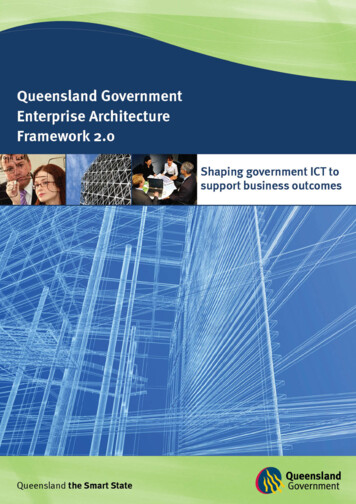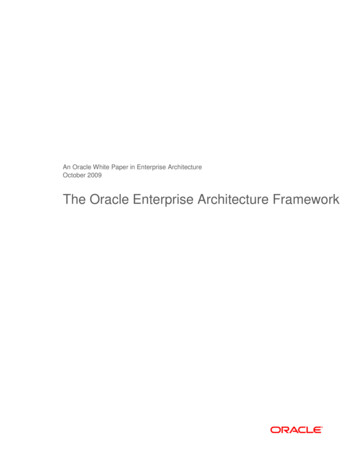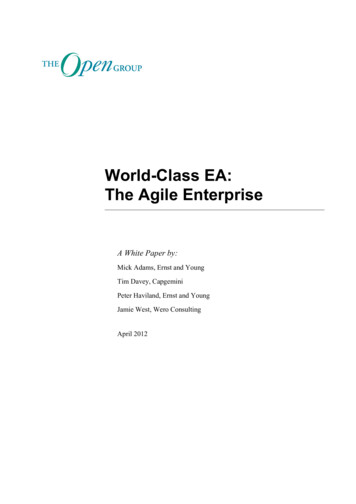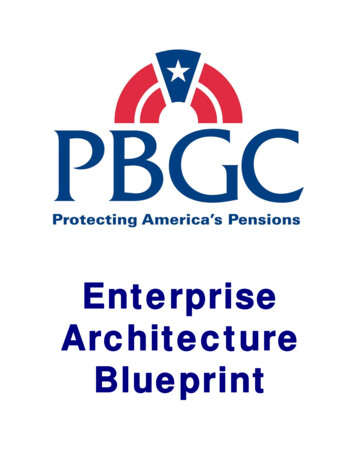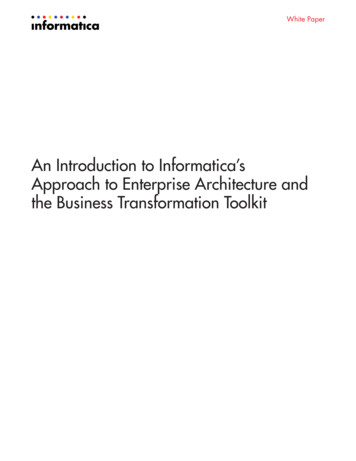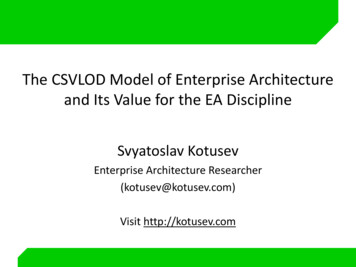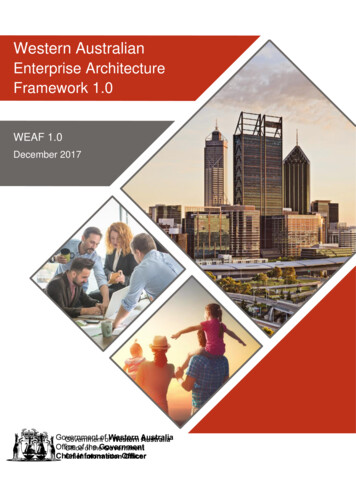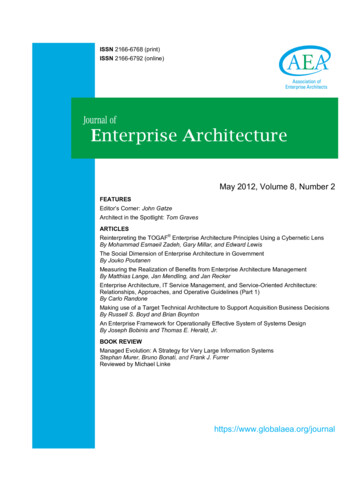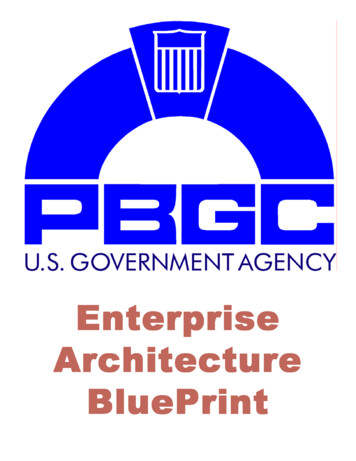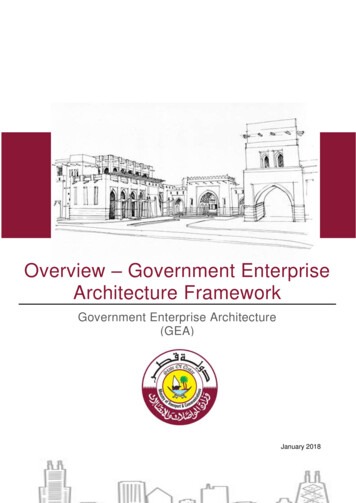
Transcription
Overview – Government EnterpriseArchitecture FrameworkGovernment Enterprise Architecture(GEA)January 2018[Type here]
Government Enterprise ArchitectureTable of Contents1Legal Mandate . 42Introduction . 52.133.13.24Principles .5Framework . 7Structure .7How to Apply.8GEA Reference models . 94.1Dimensions .94.2Metamodel.10Metamodel Concepts .10Metamodel Layers .104.3Business Reference Model (BRM) .12Introduction.12Relationships .12Benefits .13Artefacts .134.4Information Reference Model (IRM) .15Introduction.15Relationships .15Benefits .15Artefacts .164.5Application Reference Model (ARM) .16Introduction.16Relationships .17Benefits .17Artefacts .184.6Infrastructure (Technical) Reference Model (TRM) .18Introduction.18Relationships .18Benefits .19Artefacts .194.7Security Management .20Introduction.20Benefits .20Artefacts .204.8Service Management .21Introduction.21Benefits .21Artefacts .214.9Governance Framework.21Introduction.21Benefits .22Artefacts .225Glossary . 23Overview - Government Enterprise Architecture Framework2
Government Enterprise ArchitectureTable of FiguresFigure 1 - GEA Summary View . 7Overview - Government Enterprise Architecture Framework3
Government Enterprise Architecture1 Legal MandateArticle 18 of the Emiri Decree number (4) for the Year 2016 setting the mandate of Ministry ofTransport and Communications (hereinafter referred to as “MOTC”) provides that MOTC hasthe authority to regulate road and maritime transport activities, to develop and enhance transportservices, to study, supervise and follow up the execution of their projects, leading toaccomplishing an expansion to the economical motion and serve the national development plan.Also to supervise, regulate and develop the sectors of Information and CommunicationsTechnology (hereinafter “ICT”) in the State of Qatar in a manner consistent with the requirementsof national development goals, with the objectives to create an environment suitable for faircompetition, support the development and stimulate investment in these sectors; to secure andraise efficiency of information and technological infrastructure; to implement and supervise egovernment programs; and to promote community awareness of the importance of ICT toimprove individual’s life and community and build knowledge-based society and digital economy.Council of Ministers’ Resolution No. (18) of 2010 on the implementation of e-government policiesrequires government agencies in Qatar to implement Government Reference Architecture andStandards policy. In line with Qatar Digital Strategy 2020, this document has been developed toupdate and replace the architecture and standards issued in 2007.This document has been prepared taking into consideration current applicable laws of the Stateof Qatar. In the event that a conflict arises between this document and the laws of Qatar, thelatter, shall take precedence. Any such term shall, to that extent be omitted from this document,and the rest of the document shall stand without affecting the remaining provisions. Amendmentsin that case shall then be required to ensure compliance with the relevant applicable laws of theState of Qatar.Overview - Government Enterprise Architecture Framework4
Government Enterprise Architecture2 IntroductionThis document provides a high-level overview of the Qatari Government Enterprise Architecture(GEA) Framework that would be used by all the government agencies in Qatar. It describes thestructure of the framework and the artefacts aligned with multiple dimensions of the framework.It also provides guidance on how GEA artefacts can be used by MoTC and individualgovernment agencies in Qatar.The intent of this GEA framework is to assist in the delivery of more consistent and cohesiveservices to citizens and support efficient delivery of digital services by the government, byproviding a framework that: Provides a common language: provides a common language for agencies involved in the delivery of crossagency services Enhances collaboration: supports the identification of re-usable and sharable services and applications Assists in describing and analyzing IT investments: provides a basis for the objective review of investmentby government Assists in transforming Government: enables more efficient and timely delivery of e-Services through arepository of standards, principles and templates that assist in the design and delivery of ICT capabilityand, in turn, business services to citizensThis document will be the first version (version 1.0) of Government Enterprise Architecture forQatar and forms the basis for enabling collaborative cross agency projects, better publicservices, and sharing of services and information, in a customer centric way. The framework isbased on best practices outlined in US Federal Enterprise Architecture Framework (US-FEAF).2.1 PrinciplesThe value of reference models comes from applying them as part of business as usual activitiesacross agencies in a consistent manner. They are used to provide a consistent view across acomplex system of Government business services and supporting ICT services so that thedelivery of government services can become customer centric, and that investments can bemade that benefits the system as a whole, not just specific agencies. The following guidingprinciples are used while creating the GEA reference models and other artefacts.- Customer centricity: Customer insights must inform service selection, design and delivery.Customers should be shielded from the internal complexities of Government- Promote reuse: Remove fragmentation, duplication and promote consolidation and reuse ofshared capabilitiesOverview - Government Enterprise Architecture Framework5
Government Enterprise Architecture- Share Information by default: Information must be shared by default rather than by exception- Enable co-creation through a collaborative environment: Next generation of digitalservices delivery should facilitate co-creation of digital services on a shared technology platformincluding multiple agencies, 3rd party service providers and vendors- Trust and confidence: Build public trust and confidence in government’s ability to maintainthe privacy and security of information- Interoperable: Design services for interoperability using applicable standards so that systemscan work together to deliver more integrated services through a common data exchange platform- Design for future: Prepare Government services for disruptive technologies and emergingtrendsOverview - Government Enterprise Architecture Framework6
Government Enterprise Architecture3 Framework3.1 StructureThe overall structure of the GEA is organized into two sections: Whole of Government (WoG)and Agency. The framework has seven dimensions that include three cross-cutting dimensions:governance, security management, and service management. Those dimensions areoverarching and apply to both WoG and Agency. The remaining four dimensions each of whichcontaining a reference model, are: business, information, applications and infrastructure. Thesedimensions apply to both WoG and Agency, however the artefacts falling under each of thosedimension varies. Figure 1 provides the structural view of the GEA Framework, capturing thedimensions and artefacts. Details on reference model dimensions and associated artefacts aredescribed in Section 3.Figure 1 - GEA Summary ViewThe GEA framework has been elaborated in seven documents corresponding to each of theabove seven dimensions. The horizontal layers in the GEA framework representing the fourdimensions i.e. Business, Information, Application and Infrastructure, form the core of the GEAframework and each of these four dimensions have three key elements:1.2.Architecture: This section provides conceptual view of the architectural components and capabilities foreach dimension depicting relationships between the dimensional architectural components.Standards: This section provides relevant standards for each of the dimensions with each standardcategorized for compliance purpose as either mandatory, recommended or optional.Overview - Government Enterprise Architecture Framework7
Government Enterprise Architecture3.Taxonomy: This section provides reference taxonomies for each of the four dimensions to groupenterprise assets in logical categories and describe their architectural interrelationships. The aim is toensure use of common architectural language and identify opportunities for reuse.Entities shall ensure compliance to each of the above three elements for the four horizontaldimensions i.e. business, information, application and infrastructure; as well as adopt enablingpolicies and processes prescribed in the remaining three crosscutting dimensions i.e.governance, security management and service management.3.2 How to ApplyThe government entities shall apply the GEA in the following ways:1.2.Entity level(i)Entity’s Enterprise Architecture or IT Strategy: While designing entity’s enterprise architecture orIT strategy, the entities shall ensure that the Government Enterprise Architecture is referred andcomplied with.(ii)Annual IT planning: Government entities shall ensure that while planning for any new ITinitiatives, alignment to GEA is ensured aiming at reuse of government-wide information,application and IT infrastructure components.(iii)Taxonomy: Entities shall maintain architectural taxonomies as provided in the GEA to ensure useof common language across the government as well as to identify opportunities for governmentwide reuse. The entities may also use an open standards based tool recommended in Appendix3 of the Governance Model document for ease of GEA maintenance.(iv)GEA compliance assessment: The entities shall perform self-assessment to measure GEAcompliance based on the assessment template provided in Appendix 1 of the Governance Modeldocument, on an annual basis or upon request of MOTC. The entities shall report and deviationor non-compliance to MOTC as well as provide the assessment report as and when requested byMOTC.Initiative or Project level(i)Project initiation: Agencies shall include statement in each of their ICT tenders requiring vendorsto comply with GEA reference models and standards. A sample statement is provided in Appendix4 of the Governance Model document that should be included in the RFPs.(ii)Project execution: The project manager or solution architect shall ensure project’s compliance toGEA. His or her role includes designing the solution that is at all times compliant to the GEAmodels and standards. This role can also be fulfilled by vendor’s project manager/solutionarchitect and hence a statement provided in Appendix 4 of the Governance Model documentshould be included of each ICT tender of government entities.The Governance Model document should also be referred for governance processes andenabling policies aimed at adoption of GEA.Overview - Government Enterprise Architecture Framework8
Government Enterprise Architecture4 GEA Reference models4.1 DimensionsGEA has seven dimensions that represent the main focus areas of Government agencies andallows specific artefacts and relationships to be captured in a consistent way.Qatar citizens and residents will interact with the government through government deliveredservices. These services are built on business capabilities that utilize information and which arecategorized into business service domains and service areas. The business capabilities guidethe government and the agencies through their transformation, design and analysis activities.Information dimension provides a framework for government entities and agencies to reuse andexchange information. The technology assets (applications and infrastructure) will be used in away to promote efficiencies through decreasing redundancies and eliminating duplications. Thisentire process is protected through security and privacy standards. The reference models aredescribed in detail below:ReferenceModelDescriptionThis reference model describes and links the strategic goals, KPIs, businessusers, delivery channels and services, with an emphasis on customercentricity using a consistent language – taxonomy.BusinessIt defines a Business architecture framework and associated standardsproviding guidance on how new business services should be modelled,defined, developed, monitored and continuously improved throughoutservice lifecycle.This reference model describes, manages and shares information across theQatari government agency boundaries using Information referencetaxonomy.InformationIt describes the Information exchange architecture approach and standardsfor sharing information data sets across government agencies and within agovernment agency in Qatar.This reference model describes and links application services, including‘Platform as a Service’ that support the business services using ApplicationApplicationsReference taxonomy.It describes the application reference architecture that will be used to createapplications supporting Government services.Overview - Government Enterprise Architecture Framework9
Government Enterprise ArchitectureThis reference model describes the technology infrastructure that supportsthe business services, applications and information stores of governmentInfrastructureagencies.It describes the Infrastructure Reference architecture that will be thefoundation for building application components and business services.Defines the architecture governance framework to ensure effective adoptionGovernanceand evolution of reference architecture models across all the agencies inFramework andGovernment. It sets out compliance with standards and controls, andEnablersguidelines that ensure accountability for the architectural solutions within andacross agencies.Security management provides the GEA context to the related security andSecurityManagementprivacy requirements for government agencies.Service management defines the framework for managing IT services thatService Managementare required to support the delivered services.4.2 MetamodelThe Qatari Government Enterprise Architecture (GEA) metamodel describes the types ofinformation entities described in various reference models and the relationships between them.Entities are key subject areas that every reference model in GEA framework focuses on (e.g.:Business reference model focuses on performance management entities like Goals,measurement areas as well as Business services).It also depicts how the agency level entities are related to taxonomies defined at Whole ofGovernment (WoG) level.Metamodel ConceptsThe GEA metamodel illustrates the different types of entities, which are described by the GEAreference models. The concepts used in the metamodel are: Entity types: the types of information described by a reference model – e.g.: Goal, Measurement area,Service Domain, etc. Layers: groups of entity types that belong to a particular reference model dimension – e.g.: BusinessReference model, Information Reference model Relationship: connection between entity types within and across layers – e.g.: Application enable ServiceMetamodel LayersMetamodel is organized into four layers of the GEA: business, information, application andinfrastructure.Overview - Government Enterprise Architecture Framework10
Government Enterprise ArchitectureFigure 2 - GEA metamodelOverview - Government Enterprise Architecture Framework11
Government Enterprise Architecture Business reference model (BRM) provides a Performance reference taxonomy and a Services taxonomy toenable a consistent way to capture goals, key performance indicators (KPIs) and business services providedby WoG and agencies.New projects / initiatives and existing business services from WoG and agencies will be aligned to thestrategic goals defined in BRM. Performance towards the defined strategic goals will be tracked using thedefined KPIs.Service delivery channels aggregate one of more business services and are accessed by differentcustomers. Information reference model (IRM) provides the common taxonomy to classify information entities(assets) across government agencies. Information entities support business services. Application reference model (ARM) provides the common taxonomy to classify application componentsthat enables business services creation. Application components will also provide as data stores forInformation assets. Infrastructure (Technical) reference model (TRM) provides the common taxonomy to classifyinfrastructure assets in government agencies. Infrastructure assets (compute and storage hardware)hosts applications and stores information entities.4.3 Business Reference Model (BRM)IntroductionThe business reference model describes the framework of business services and products thatdeliver the output of a government agency. It also provides an outcome-focused measurementframework that can assist government agencies in the design and implementation of effectivebusiness measurement systems. Please refer Annex 1 for detailed BRM.RelationshipsThis section highlights the relationship of the BRM with other GEA Reference models.Sets the business requirements for data and information, andInformationidentifies gaps and duplication in dataSets the business requirements for application and ICT servicesApplicationsSets the business requirements for infrastructure, and identifynew technology needs or improvementsInfrastructureOverview - Government Enterprise Architecture Framework12
Government Enterprise ArchitectureBenefitsThe BRM allows agencies to classify the functions of government programs into a definedstructure. It provides value to business architecture by providing: Architectural and standards guidance on designing and developing next generation government services Promotes strong alignment between business initiatives, strategies and outcomes Supports planning and executing business activities Supports portfolio, program and project evaluation A functional view of agency business using a standard classification A common understanding of the business functions of other agencies.The benefits of BRM include:WoGBRM Benefits AgenciesMechanism to track alignment of investments investmentKPIsagency strategic goalsMeasure performance of shared services Identification of opportunities for sharing and end journey services by combining individualservicesinitiativesagainstMeasure performance of businessIdentificationofnewservicerequirements based on measuredperformanceFacilitate identification and creation of end-to-business/betweenservices against defined KPIsre-use of services relationshipsand initiatives against WoG strategic goals andagainst defined KPIs Describeprovidedagenciesbymultiple Identification and reuse WoG sharedservices and promotes collaborationwith other erencetaxonomyBusinessestablishes a more comprehensive andconsistent linking of investments andPerformance reference taxonomyactivitiestogovernmentagencies’strategic goals and objectives, agencypriority goals, cross agency priority goalsand management areas of focusOverview - Government Enterprise Architecture Framework13
Government Enterprise ArchitectureWoG performance KPIs focused on wholeWoG Performance KPIsof Government initiatives and programsIllustrates the business terminology, acomplete description and the conceptualBusiness Reference Taxonomystructure of the functions and services ofQatar GovernmentWoG catalogue of shared services offeredShared Services Catalogueby MoTC classified according to thebusiness reference taxonomy.Business architecture framework agenciesshould adopt in designing, implementingBusiness Reference Architectureandcontinuouslyimprovingnextgeneration digital dards.Individual agency KPIs aligned to thePerformanceAgency KPIstaxonomyclassificationsused to measure effectiveness of businessservices and other initiativesThe agency specific customer profiles aredefined by the agency and provide anCustomer Profilesarray of various types of customersserviced by that agencyDelivery Channel CatalogueAn agency specific channel catalogueCaptures the relationship between theDelivery Channel / Service ces CatalogueAn agency services catalogueCaptures the relationship between anCustomer / Delivery Channel / Service Matrixagency’s customers, agency providedservices and the delivery channelsOverview - Government Enterprise Architecture Framework14
Government Enterprise Architecture4.4 Information Reference Model (IRM)IntroductionThe goal of the information reference model is to facilitate easy discovery, description,management, and sharing of information within and across agencies. The model encompassesan information reference taxonomy, data description formats, and data exchange descriptionformats. Please refer Annex 2 for detailed IRM.RelationshipsThis section highlights the relationship of the IRM with other GEA Reference models.Provides the information structures that support business services;improve business process and decision making through dataBusinesssharingProvides the authoritative information entity structures to be usedApplicationsby application and ICT servicesProvides the information specific requirements for technology andinfrastructure services (e.g.: in-memory computing needs, big dataInfrastructurestorage, etc.)BenefitsThe IRM provides value for agency data architecture initiatives by providing a means toconsistently describe data architectures. The IRM’s approach to data description, data contextand data sharing enables data architecture initiatives to uniformly describe their data andinformation, resulting in increased opportunities for cross-agency interactions.The benefits of IRM include:WoGIRM Benefits Improving discovery, access, and sharing ofAgencies data Improving discovery and access ofInformation assets across multipleagencies for new programs andIdentification of redundant data collection byinitiativesgovernment agencies and promoting dataexchange for those scenarios ation managementOverview - Government Enterprise Architecture Framework15
Government Enterprise Architecture Identificationofauthoritativesourcesofinformation across government Acceleration of open data initiative by improvingdata discovery and accessArtefactsArtefactDescriptionThe taxonomy defines the way in whichInformation Reference Taxonomy, Datainformationcanbedescribed,description, Data exchange standardscategorized and shared. It also facilitatesdiscovery and exchange of core dataDefinesthereferenceInformation Exchange ngeinformation across government agenciesand within formation exchange technologies andStandardsemerging technologies such as Big data,IoT, etc.GDX exchanged information assetsplatformclassified as per the IRM taxonomyCatalogue capturing information assetsproduced or consumed by an agencyInformation Assets Catalogueclassified as per the defined Informationreference taxonomyCaptures the relationship between anBusiness Service / Information matrixagency’s services and the relevantinformation assets4.5 Application Reference Model (ARM)IntroductionARM describes the applications that supports the business services provided by governmentagencies. It includes:Overview - Government Enterprise Architecture Framework16
Government Enterprise Architecture Core business applications COTS corporate applications Domain specific applications Infrastructure & Platform Software components End user computing applicationsPlease refer Annex 3 for detailed ARM.RelationshipsThis section highlights the relationship of the ARM with other GEA Reference models.Provides the application and ICT services that support businessBusinessservices, processes, and capabilitiesProvides requirements and tools to manage, model, structure,Informationshare, and exchange data and informat
The GEA framework has been elaborated in seven documents corresponding to each of the above seven dimensions. The horizontal layers in the GEA framework representing the four dimensions i.e. Business, Information, Application and Infrastructure, form the core of the GEA framework and each of these four dimensions have three key elements: 1.
